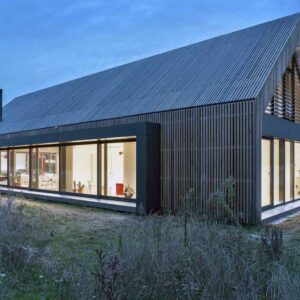In the heart of Chile’s coastal landscape, where the whisper of the waves meets the rugged embrace of the mountains, stands a house that tells a tale of two woods. The ribbed Raulí, known for its resilience and beauty, wraps the exterior, while the laminated pine, with its strength and warmth, forms the core. This is a story of how these two woods met, intertwined, and created a symphony of architecture and nature.







The Allure of Ribbed Raulí
The Raulí tree, native to the temperate rainforests of Chile, has long been celebrated for its rich, reddish-brown hue. Its timber, when cut and polished, gleams with an inner fire, reflecting the very soul of the forest from which it came.
As cladding, ribbed Raulí offers more than just beauty. Its grooved texture provides a tactile experience, inviting touch, and evoking memories of nature’s intricate designs.
The durability of Raulí is legendary. It stands defiantly against the elements, its natural oils protecting it from decay, making it an architect’s dream for exterior applications.
Beyond its physical attributes, Raulí carries a cultural significance. For the local communities, it’s a bridge to their ancestors, a wood steeped in folklore and tradition.
In this coastal abode, the ribbed Raulí cladding is not just a design choice; it’s a statement. A declaration of love for the land and its treasures.





Laminated Pine: The Backbone
Laminated pine, with its layers bonded together, boasts of unparalleled strength. It’s this strength that forms the backbone of the house, supporting, uplifting, and giving it shape.
The beauty of laminated pine lies in its versatility. It can be molded, shaped, and crafted to fit the most intricate of designs, making it a favorite among modern architects.
Within the house, the pine’s warm tones contrast beautifully with the cooler shades of the Raulí exterior. This interplay of colors creates a visual treat, a dance of light and wood.
Environmentally conscious choices are the need of the hour, and laminated pine delivers. Sourced sustainably, it ensures that the beauty of today doesn’t rob tomorrow of its green.
Every beam, every plank of laminated pine in the house tells a story. A story of craftsmanship, of precision, and of a deep-rooted respect for nature’s bounty.




The Harmony of Interior and Exterior
The house, in its essence, is a dialogue between the inside and the outside. The ribbed Raulí cladding, with its rhythmic patterns, beckons from afar, drawing one closer with every step.
As one enters, the warmth of the laminated pine envelops them. It’s a stark contrast, yet it feels seamless, as if the woods were always meant to meet this way.
The large windows, framed by the sturdy pine, offer glimpses of the Raulí-clad exteriors. It’s a constant reminder of the dance between the two materials, even when one is ensconced within the house.
The design choices, from the layout to the fixtures, all pay homage to the two woods. They are the silent heroes, influencing every decision, shaping every corner.
The play of natural light within the house accentuates the textures of both woods. The ribbed Raulí reflects the sun’s rays in a myriad of patterns, while the laminated pine glows with a soft luminescence.


Sustainability and Modern Architecture
In an age where sustainability is paramount, the choice of local woods like Raulí and pine speaks volumes. It’s not just about aesthetics; it’s about responsibility.
Modern architecture is increasingly leaning towards materials that have a minimal carbon footprint. Both Raulí and laminated pine fit the bill, being renewable and requiring less energy to process.
The house stands as a beacon for sustainable design. Every nook and cranny echoes the ethos of building with nature, not against it.
The longevity of these materials ensures that the house will stand the test of time, with minimal maintenance. It’s a nod to the future, a promise of lasting beauty.
Beyond the house itself, the landscape around it thrives. The choice of native woods ensures that the local ecosystem remains undisturbed, allowing flora and fauna to flourish.


Conclusion
The house, with its ribbed Raulí exterior and laminated pine core, is more than just a dwelling. It’s a lesson in harmony, sustainability, and the timeless beauty of wood. It stands as a testament to what can be achieved when architecture respects and celebrates nature.












